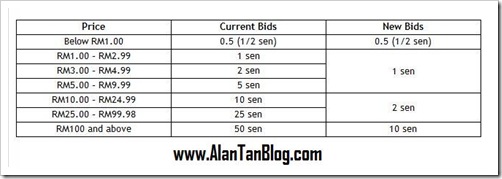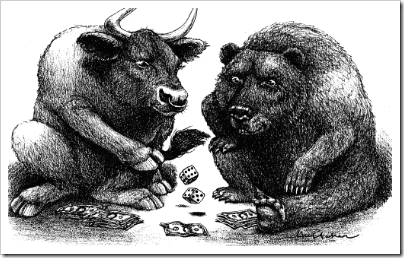New Minimum Bids Structure|Bursa Malaysia
With effect from 3rd August 2009(Monday), Bursa Malaysia has reduced the structure of the minimum bids for a stock as per table below.
What is Minimum Bid?
A minimum bid is the permissible change on the offer to buy price over the previous done or quoted price. In other word it mean minimum price variation between the stocks’ buy and sell bid.
Say the last price done for Berjaya Sports Toto Berhad (BJTOTO) is RM4.36 then the next up price is RM4.38 or next down price is RM4.34 (RM0.02 Price difference)
When trading on Bursa Malaysia, bids and offers for shares within different price ranges follow different minimum bids.
Will this actually result the price of the stocks be more Volatile moving up and down faster and increased the Bursa trading volume ?
We shall see and stay Tune. 😀
—————————————————————————————
Equity investment: What is tick size and how do investors benefit
EQUITY investment strategies take account of many factors, including tick sizes which are set by a stock exchange.
Here is a primer on tick sizes and how investors benefit from a smaller value.
This educative article is in conjunction with the introduction of a smaller tick size which will be made available by Bursa Malaysia and is planned for implementation on Aug 3.
Equity investors rely a lot on research and information to forecast the potential price appreciation of a stock. This ranges from fundamental analysis of the company to a technical analysis of its historical price movements. There is also a little known indicator known as a spread that can be used by investors to gauge the near-term movement of a particular stock. A stock’s spread is closely influenced by a “tick size”.
Understanding Spreads. Every share that trades on the stock market has a best buy and a best sell price. The best buy price is the highest price in the order book placed by interested buyers for a specific share while the best sell price is the lowest price in the order book placed by interested sellers.
These two prices are determined by demand and supply, which can be seen as a negotiation process between two parties.
The spread is the difference between a share’s best buy and best sell price. The general belief is that a consistently large spread signals low volume for that respective stock.
On the other hand, a narrow spread can indicate that a transaction will occur soon. For example, a stock with a buy/sell price of RM10 and RM10.02 suggests that buyers and sellers are very close to making a trade. If the narrow spread continues, volume for the respective share is expected to be high. A wider spread means that greater changes in the share’s buy or sell price is needed before a transaction can conclude.
Tick Sizes in a Spread. The magnitude of a stock spread is influenced by the tick size or the minimum tick size structure.
This refers to the smallest allowable price variation between the buy and sell price of a stock. The spread of a share can narrow if the tick size is reduced.
In the past few years, many global stock exchanges reduced their permitted tick size as this initiative was found to boost liquidity and efficiency to the capital market as a whole.
To stay competitive and relevant, Bursa Malaysia is also implementing a smaller minimum tick size for all shares and exchange traded funds (ETFs) trading on the local market (see table 1 and 2). Under the new structure, a share with a buy price under RM5 will have a new tick size of 1 sen instead 5 sen. This means, interested buyers or sellers of this respective stock can now enter a buy or sell price of 1 sen instead of 5 sen.
The equity ETFs on the main board also benefit from a smaller tick size. Smaller tick sizes encourage active trading as there are many benefits for retail investors (see box story).
The reduction of tick size is expected to attract more trading volume due to improved opportunities as investors now will have more choice of entering or exiting the market just by smaller trading ticks. In short, this reduction of tick sizes will enable price discovery, leading to a positive impact on market liquidity.
In respect to the bidding price for buying-in, the exchange will retain the 10 ticks. Arising from this, the buying-in price will be based on the current tick sizes instead of the new tick sizes to ensure that the buying-in price is attractive to potential sellers.
From:http://biz.thestar.com.my/news/story.asp?file=/2009/7/27/business/4390115&sec=business




New Minimum Bids Structure|Bursa Malaysia |stock market | DISCOVER the Road to Financial FREEDOM!…
With effect from 3rd August 2009(Monday), Bursa Malaysia has reduced the structure of the minimum bids for a stock as per table below.
What is Minimum Bid?
A minimum bid is the permissible change on the offer to buy price over the previous done or qu…
[…] DISCOVER the Road to Financial FREEDOM! “INSIDER” Ideas to Manage YOUR PERSONAL FINANCE So YOU will be More Wealthier(and happier) « New Minimum Bids Structure|Bursa Malaysia […]
Changes to listing rules proposed
By ERROL OH
KUALA LUMPUR: Proposed amendments to Bursa Malaysia’s listing requirements and the introduction of the Corporate Disclosure Guide (CD Guide) are set to prod listed companies into revealing more details about key developments, including changes of directors, chief executive officers (CEOs), chief financial officers (CFOs), external auditors and independent advisers.
The revamp also covers disclosure rules for quarterly and annual reports, pledging of shares by controlling shareholders, termination of corporate proposals and voting results of shareholder meetings (see table). Some of these proposed improvements are seen as possible remedies to recent cases of poor corporate governance and stinginess with information.
In a media release yesterday, Bursa Malaysia said the CD Guide and the suggested changes to the listing requirements were aimed at promoting further transparency, quality and efficiency of the Malaysian capital market.
Said chief regulatory officer Selvarany Rasiah: “The proposed amendments are part of the exchange’s ongoing efforts to enhance the regulatory framework for listed issuers to ensure the competitiveness and attractiveness of Bursa Malaysia as a listing and investment destination.
“Maintenance of market integrity remains our key focus in formulating the proposed amendments, and in so doing, we strive to strike a careful balance between enhancing market regulation and promoting business efficacy.”
To come up with the proposals, the exchange took into account industry feedback, findings and observations from supervision and monitoring activities, stakeholder engagement, and international standards.
In a move to improve the quality of the stewardship of listed companies, the stock exchange plans to make it mandatory for a listed company to give its grounds for appointing a director or for nominating him for election.
“This includes the reasons why the listed issuer is of the view that the director has the character, experience, integrity, competence and time to effectively discharge his role as a director of the listed issuer.
In the case of an appointment of an independent director, we propose the listed issuer also sets out the reasons why the listed issuer considers the independent director as being ‘independent’,” says Bursa Malaysia in a consultation paper issued yesterday, which sets out the proposed amendments to the listing requirements.
A second consultation paper, also released yesterday, invites public feedback on the draft CG Guide. Bursa Malaysia said this consultation paper was meant to clarify the disclosure requirements set out in the listing requirement and to illustrate how the disclosure requirements should be applied. It also set out best practices for establishing policies and procedures to enable listed issuers to fulfil their disclosure obligations.
“The proposed CD Guide seeks to provide greater clarity and guidance to help listed issuers in better understanding and complying with their disclosure obligations under the listing requirements,” said Selvarany in the media release.
In addition, if the new disclosure rules are implemented, the companies will have to provide extra information in their quarterly and annual reports so as to enable investors to better understand the companies’ financial performance.
One proposal is to replace the performance reviews in the notes to quarterly reports with detailed analyses that set out material factors affecting the companies’ earnings and revenue. The idea is to eliminate cookie-cutter reviews that state the obvious. Bursa Malaysia has also proposed that the listing requirements prescribe certain items that ought to be incorporated in the income and cash flow statements in the quarterly reports.
Another interesting proposal is the requirement that the listed companies disclose the reasons for the resignation or change of directors, CEOs, CFOs, external auditors and independent advisers. This is partly to enable the detection of red flags, if any.
“Such disclosure would be particularly pertinent in instances where it arises from irregularities taking place in the listed issuer,” said Bursa Malaysia in the consultation paper on the proposed amendments to its listing requirements.
The deadline for submitting written comments on the two consultation papers, which can be downloaded from Bursa Malaysia’s website, is Aug 19.
“We expect diverse views on the consultation papers,” Selvarany told StarBiz. “We keep a very open mind. We want all constructive feedback. There may be some issues that we have not considered and we are prepared to take on board the relevant comments.”
fr:biz.thestar.com.my/news/story.asp?file=/2010/7/16/business/6673744&sec=business
Bursa 2Q10 net profit dips 21% y-o-y
KUALA LUMPUR: Bursa Malaysia net profit for the second quarter ended June 30, 2010 fell by 21.4% to RM27.5mil from RM35mil a year ago on lower trading revenue.
Bursa said equities trading revenue decreased by 23% to RM36.8mil in 2Q10 compared to 2Q09.
In a statement to the stock exchange Friday,the stock market operator said revenue fell to RM84.27mil from RM94.58mil a year ago.
It declared an interim single-tier dividend of 9.5 sen per share.
fr:biz.thestar.com.my/news/story.asp?file=/2010/7/16/business/20100716152711&sec=business